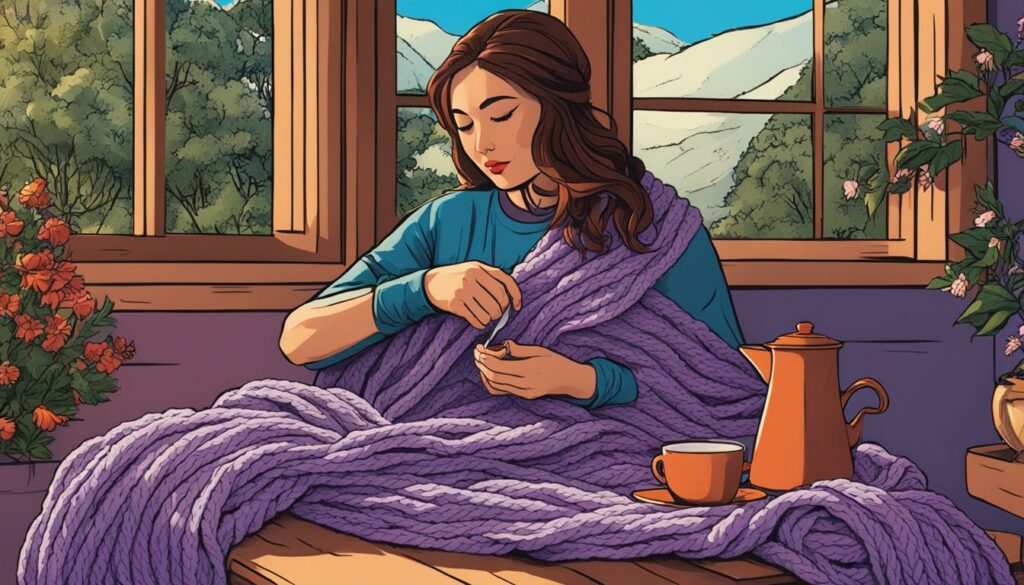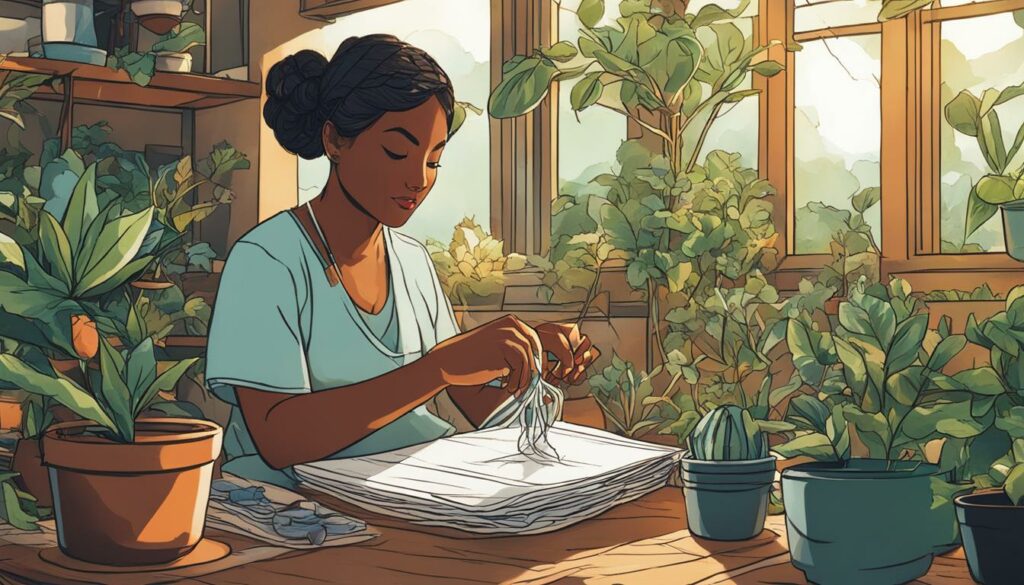Crafting has emerged as a powerful tool for promoting mental wellness and nurturing our overall well-being. Engaging in creative activities such as knitting, painting, and DIY projects can have a profound impact on our mental health, offering a therapeutic outlet for those dealing with anxiety, depression, and chronic pain.
One individual, Sarah Huerta, found solace and relief from her post-traumatic stress disorder and extreme anxiety through the practice of knitting. This personal experience is just one example of the countless stories highlighting the beneficial effects of crafting on mental wellness.
Research has shown that crafting can induce a state of flow, similar to meditation, which helps to temporarily suspend negative thoughts and emotions. The act of creating releases dopamine, a natural anti-depressant, and can improve self-efficacy and cognitive function. Furthermore, crafting provides stress reduction, cognitive benefits, and social connection, making it a holistic approach to mental health.
In this article, we will explore the healing potential of crafting for mental health. We will dive into the science behind this therapeutic practice, discover the benefits it offers, and showcase how crafting can be a valuable addition to our self-care routines. Let’s embark on a journey of mindful making together!
Key Takeaways:
- Crafting has a therapeutic impact on mental wellness, providing relief from anxiety, depression, and chronic pain.
- Engaging in creative activities induces a state of flow and temporarily suspends negative thoughts and emotions.
- Crafting releases dopamine, improves cognitive function, and offers stress reduction.
- Crafting provides a holistic approach to mental health, fostering social connection and promoting overall well-being.
- Creating a routine of crafting can be a valuable addition to self-care practices.
The Healing Craft: An Overview of Crafting for Mental Health
Crafting has emerged as a powerful tool for enhancing mental health and overall well-being. Through various creative activities, individuals can find solace, express themselves, and experience positive effects that promote mental wellness. Whether it’s knitting, painting, or pottery, engaging in the process of crafting can have a profound impact on our mental state.
Knitting Away Anxiety: A Personal Journey
One person who experienced the transformative power of crafting is Sarah Huerta. Struggling with post-traumatic stress disorder and extreme anxiety, Sarah turned to knitting as a way to cope with her emotions. The rhythmic, repetitive motions of knitting allowed her to calm her mind, focus her thoughts, and find a sense of peace. Through the process of creating beautiful and intricate designs, she found a cathartic release that helped alleviate her anxiety.
The Science Behind Crafting and Stress Relief
Scientific research supports the positive impact of crafting on mental health. Crafting activates the parasympathetic nervous system, which is responsible for promoting relaxation and reducing stress. Similar to meditation, the act of crafting induces a state of focus and mindfulness, diverting attention away from negative thoughts and emotions. This meditative state helps to alleviate anxiety, lower blood pressure, and promote a sense of calm.
“Crafting activates the parasympathetic nervous system, which reduces stress and promotes relaxation.”
Moreover, engaging in creative activities stimulates the release of dopamine, a neurotransmitter associated with pleasure and reward. This natural “feel-good” chemical can enhance mood, reduce symptoms of depression, and boost overall well-being. Additionally, crafting improves cognitive function, enhancing memory, focus, and problem-solving skills.
Crafting as a Nonpharmacological Approach to Wellness
One of the significant advantages of crafting for mental health is its nonpharmacological nature. Unlike medication, crafting does not come with any potential side effects or risks. It offers a holistic approach to wellness that empowers individuals to take control of their mental health. By engaging in creative expression and self-care through crafting, individuals can experience the positive effects of art therapy without relying solely on medication.
Crafting provides a safe and nurturing space for self-expression, self-discovery, and personal growth. From painting to jewelry making, the act of creating something with our hands allows us to tap into our inner creativity, cultivate mindfulness, and embrace the therapeutic benefits of crafting.

With the combination of personal anecdotes, scientific evidence, and the availability of nonpharmacological approaches to wellness, it is clear that crafting has immense potential as a tool for improving mental health and overall well-being. The next section will explore the specific application of crafting as a form of art therapy for mental health and the benefits it can offer.
Crafting to Soothe the Mind: Embracing Art Therapy for Mental Health
Art therapy can be a powerful tool for promoting mental health and well-being. Engaging in creative activities, such as crafting, has been shown to reduce stress, promote relaxation, and improve overall emotional well-being. Craft projects, also known as mental health crafts or therapeutic crafts, offer a unique outlet for self-expression and can be particularly beneficial for individuals dealing with trauma or emotional difficulties.
Crafting can serve as a form of mindfulness, allowing individuals to be fully present in the moment and engage their senses. The act of creating something with your hands can help to calm the mind, providing a therapeutic and soothing experience. It offers a break from negative thoughts and emotions, allowing individuals to focus on the creative process and find a sense of peace.
Art therapy, including crafting, has been shown to improve self-esteem and provide a sense of accomplishment. Creating something with your own hands can boost confidence and provide a tangible reminder of your skills and abilities. It allows for self-expression and can be a cathartic experience, releasing emotions and providing a sense of relief.
Research has also shown that engaging in creative activities, such as crafting, can have a positive impact on overall mental health. Crafting has been linked to reduced symptoms of anxiety and depression, improved mood, and increased feelings of happiness and well-being.
Art therapy and crafting can be integrated into various mental health treatment programs, providing individuals with a complementary approach to healing. Whether it’s through painting, knitting, or other creative endeavors, art therapy offers a unique way to explore and process emotions, improve self-awareness, and promote overall mental wellness.

By embracing art therapy and engaging in therapeutic crafts, individuals can find a sense of calm, creativity, and self-discovery. Whether it’s exploring new craft projects or revisiting old favorites, the act of creating can provide a much-needed escape and contribute to a healthier mind and well-being.
Engaging the Senses: DIY Projects for Mental Wellbeing
Incorporating DIY projects into your self-care routine can have a profound effect on your mental wellbeing. The hands-on nature of crafting engages your senses and allows you to fully immerse yourself in the creative process.
The Mindful Connection of Hands-on Creation
When you embark on a DIY project, whether it’s painting, woodworking, or knitting, you engage not only your hands but also your mind. The act of creating something from scratch requires focus and concentration, allowing you to be fully present in the moment. This mindful connection to hands-on creation can bring a sense of calm and clarity to your mind.
Engaging your senses through touch, sight, and even smell further enhances the therapeutic benefits of DIY projects. As you work with different materials, you can feel the texture and weight of the materials, observe the vibrant colors, and even enjoy the soothing scents of certain crafting supplies.

Finding Flow in Crafting Complex Patterns
One of the unique aspects of DIY projects is the opportunity to challenge yourself with complex patterns and designs. Whether it’s tackling a challenging knitting pattern or creating intricate paper crafts, these tasks can transport you into a state of flow.
Flow refers to the optimal state of consciousness where you are fully absorbed in the activity at hand. As you dive into a complex project, you become completely focused, losing track of time and the worries of everyday life. This state of flow can be deeply rewarding and therapeutic, providing a much-needed break from stress and worries.
DIY Crafting for Mindful Relaxation and Focus
Engaging in DIY projects also offers a unique opportunity for mindful relaxation and focus. By directing your attention to the task at hand, you can temporarily quiet your mind and find respite from racing thoughts.
Whether you’re embroidering, painting, or building something, the repetitive and rhythmic motions of crafting can have a calming effect on your nervous system. The repetitive nature of these activities helps activate the parasympathetic nervous system, promoting relaxation and reducing stress.
Moreover, DIY crafting allows you to focus on a single task, offering a break from multitasking and digital distractions. This focused attention can improve your concentration and provide a much-needed respite from the constant buzz of technology.
By incorporating DIY projects into your self-care routine, you can tap into the mindful and therapeutic benefits of hands-on creation. Engaging your senses, finding flow in complex patterns, and promoting mindful relaxation and focus can contribute to improved mental wellbeing and a greater sense of balance in your life.
Crafting for Mental Health: The Intersection of Creativity and Science
Incorporating crafting into mental health activities not only provides a creative outlet but also taps into the intersection of creativity and science. This section explores the fascinating insights from both neurological studies and behavioral research, showcasing the immense benefits of therapeutic crafting for mental wellness.
Neurological Insights: Crafting’s Impact on the Brain
Neurological studies have shed light on the impact of crafting on the brain. Engaging in creative activities stimulates various areas of the brain, promoting improved cognitive function and overall mental well-being. For example, crafting has been found to activate the prefrontal cortex, which is responsible for decision-making, problem-solving, and executive functioning. This activation strengthens neural connections and can enhance memory, attention, and cognitive flexibility.
Furthermore, crafting has shown to increase the release of dopamine, a neurotransmitter associated with pleasure and reward. This release not only provides a sense of enjoyment but also acts as a natural anti-depressant, potentially alleviating symptoms of anxiety, depression, and stress. Additionally, the repetitive and rhythmic motions involved in crafting can induce a meditative state, reducing anxiety and promoting relaxation.
Behavioral Studies: Crafting’s Role in Psychological Health
Behavioral studies have also highlighted the positive effects of crafting on psychological health. Research has shown that engaging in creative outlets for mental health can significantly improve mood and emotional well-being. Crafting provides a sense of accomplishment and self-efficacy, boosting self-esteem and confidence.
Moreover, therapeutic crafting has been found to reduce symptoms of anxiety and depression. The act of creating something tangible can distract individuals from negative thoughts, providing a temporary respite from stress and worry. This shift in focus towards a creative and enjoyable activity can improve overall psychological health and foster a more positive outlook.
Long-Term Cognitive Benefits of Regular Crafting
Regular engagement in crafting activities for mental wellness can result in long-term cognitive benefits. Studies have shown that individuals who participate in creative outlets, such as DIY projects for mental health, have improved memory and cognitive flexibility. The combination of cognitive stimulation and the emotional well-being derived from creating can help maintain cognitive function as individuals age.
Crafting also offers a unique opportunity for continuous learning and exploration, as individuals can experiment with different materials, techniques, and projects. This ongoing engagement in new and challenging crafts can promote brain health and neuroplasticity, supporting cognitive growth and development throughout the lifespan.
In conclusion, the fusion of creativity and science in crafting for mental health provides a holistic approach to self-care and well-being. By harnessing the neurological benefits and positive impact on psychological health, individuals can incorporate therapeutic crafting into their daily lives as a powerful tool for mental wellness.
Community Threads: Crafting as a Social Glue for Mental Wellness
Crafting goes beyond individual benefits and can play a significant role in fostering a sense of community and connection among individuals. The act of creating together in a group setting can provide a supportive and validating environment for mental wellness. Craft therapy programs specifically designed to provide mental health support through art have emerged as a powerful tool for individuals seeking healing.
One of the key advantages of crafting as a social activity is the opportunity for social interaction and meaningful connections. Engaging in crafting with others allows individuals to share their experiences, stories, and challenges, creating space for empathy and understanding. This communal aspect of crafting helps individuals feel valued and supported, reducing feelings of isolation and loneliness.
Crafting in a group also provides a platform for individuals to express themselves creatively and connect with others who may be facing similar mental health challenges. It offers a safe space to explore emotions and experiences while receiving validation and encouragement from fellow crafters. Crafting together can strengthen social bonds and build a sense of belonging, promoting overall mental wellness.
Craft therapy programs, managed by mental health professionals, utilize art as a medium for healing and self-expression. These programs integrate various forms of craft therapy, such as painting, pottery, and textile art, to support individuals in their journey towards mental wellbeing. Participating in craft therapy not only provides an outlet for creative expression but also offers therapeutic benefits, such as stress reduction, improved self-esteem, and increased self-awareness.
By creating together and sharing their stories, individuals in craft therapy programs find solace, connection, and healing. The process of crafting becomes a powerful tool for personal growth, resilience, and recovery. Craft therapy programs act as a catalyst for positive change, enabling individuals to develop coping skills, explore their emotions, and build a supportive network.
Crafting as a social glue for mental wellness can bring people together, break down barriers, and create a sense of unity. Whether it’s through organized craft therapy programs or informal crafting groups, the act of creating together fosters a supportive and nurturing environment. The power of community threads in crafting is undeniable, offering a unique and accessible way to support mental health and wellbeing.
Stitching Together a Healthier Self: Crafting As Self-Care
Engaging in crafting activities can be a powerful form of self-care, offering a range of benefits for mental wellness. By establishing crafting routines as part of a daily self-care practice, individuals can experience profound improvements in their overall mental health.
Crafting Routines for Daily Mental Health Support
Creating a consistent crafting routine can provide much-needed structure and support for mental well-being. By setting aside dedicated time each day for crafting, individuals can establish a calming and meditative practice that acts as a form of self-soothing and stress relief. Engaging in DIY mental health activities such as knitting, painting, or pottery allows individuals to immerse themselves in a creative process that promotes relaxation and mindfulness.
Self-Expression and Empowerment Through Crafting
Crafting serves as a powerful medium for self-expression, enabling individuals to explore their emotions and channel their thoughts into tangible creations. The act of crafting allows for the release of pent-up emotions and serves as a therapeutic outlet for stress and anxiety. By engaging in creative expression for mental wellness, individuals can gain a sense of empowerment and achievement, boosting their self-esteem and overall emotional well-being.
The Role of Crafting in Establishing a Balanced Self-Care Regime
Incorporating crafting into a balanced self-care regime provides a holistic approach to mental wellness. Crafting as a coping mechanism allows individuals to redirect their focus and temporarily escape from daily pressures, promoting relaxation and a sense of calm. Mindfulness crafts for mental well-being, such as origami or coloring, can help individuals cultivate mindfulness and be fully present in the moment. By making crafting a regular part of their self-care routine, individuals can foster a positive mindset and enhance their overall well-being.
How Does Crafting Contribute to Mindful Wellness?
Crafting allows for a peaceful escape from daily stress, promoting mindfulness and relaxation. Engaging in creative activities, such as knitting or painting, fosters a sense of calm and focus, similar to mindful eating techniques everyday wellness. The process of making something with your hands can also boost self-esteem and provide a sense of accomplishment.
Source Links
- https://www.cnn.com/2014/03/25/health/brain-crafting-benefits/index.html
- https://www.craftscouncil.org.uk/stories/4-reasons-craft-good-your-mental-health
- https://www.yourmindfulbliss.com/creative-pursuits/20240105-crafting-your-way-to-wellness-embrace-a-hobby-for-a-healthier-you

